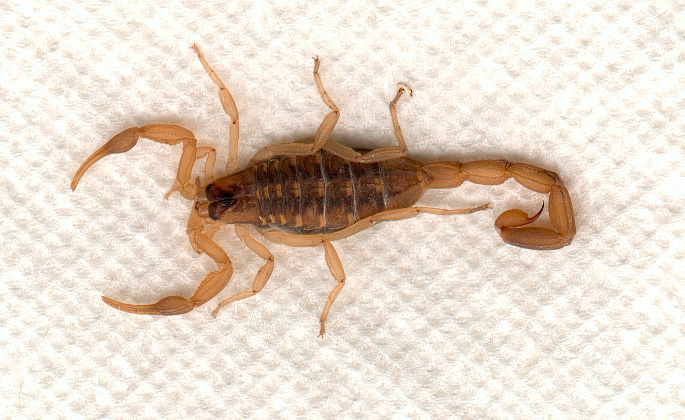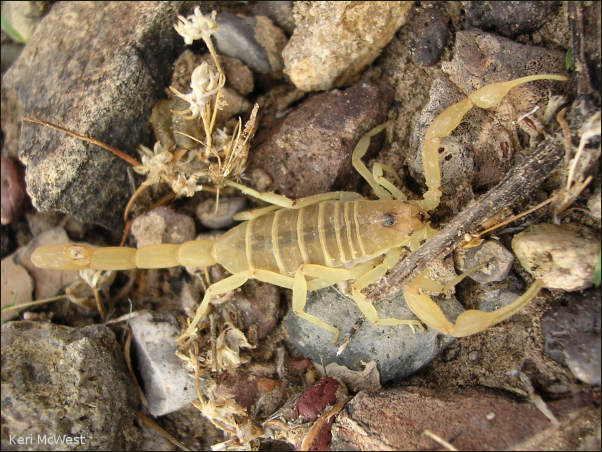


Striped Bark Scorpion (Centruroides vittatus), Randall County, Texas. Photograph by Kari McWest

Striped Bark Scorpion (Centruroides vittatus "pantheriensis"), Presidio, Texas. Photograph courtesy of Kari McWest
Physical Characteristics
Yellow to tan with two broad, dark longitudinal stripes on the upper side of the abdomen. Big Bend area specimens often show very faint or no stripes. Slender pincers and a long, slender tail are characteristic. Males generally have longer tails than females. Average adult length is 60 mm.
Habitat
Centruroides vittatus is often found under rocks, boards, and in detritus. The species are active foragers who do not burrow. Also known as bark scorpions for their frequent association with dead vegetation and fallen logs, they are often found in human dwellings. Their tendency to climb leads to them to often being found in attics.
Geographic Range
The species is distributed from eastern Colorado east to Iowa to about the Mississippi and thence south. In New Mexico, it is bounded on the west by the Sangre de Cristo Mountains and the Rio Grande, but passes south of that river marginally in Chihuahua and throughout much of Coahuila, Nuevo León, and Tamaulipas.
Diet
Centruroides vittatus, like the other Buthidae, eats other arthropods. Included in its diet are spiders, solfugids, other scorpions, and an array of insect prey.
Reproductive Characteristics
Mating takes place in the spring, early summer, and fall. Gestation is about 8 months and litter sizes average about 30.
Remarks
The sting causes local pain and swelling. Reports of deaths from the sting of this species have not been substantiated. Centruroides vittatus is one of the more common scorpions in Trans-Pecos Texas, comprising about 80% of the scorpions in the sandy desert east of El Paso and south, down into Mexico.
Literature Cited
Jackman, J. A. 1997. A field guide to spiders and scorpions of Texas. Gulf Press, Houston.
Polis, G. A. 1990. The biology of scorpions. Stanford University Press, Stanford, CA.
Shelley, R. M., and W. D. Sissom. 1995. Distributions of the scorpions Centruroides vittatus (Say) and Centruroides hentzi (Banks) in the United States and Mexico (Scorpiones, Buthidae). Journal of Arachnology 23:100-110.
Web Resources
Scorpions of the Chihuahuan Desert
Aaron Bodor, June 2006
Last Update: A.H. Harris, 4 Jul 2006.
